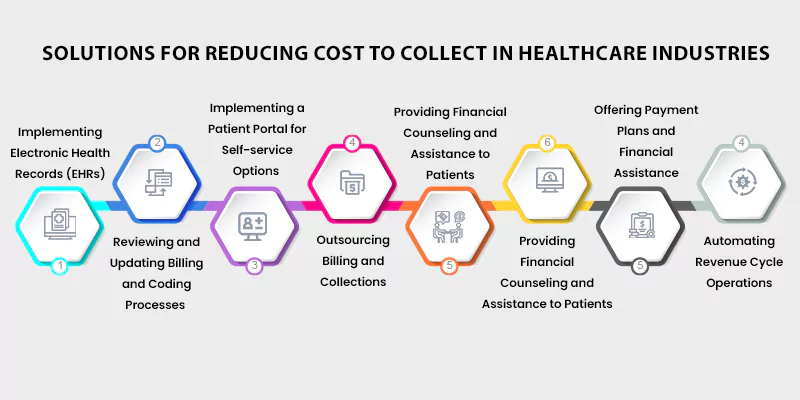By Leo John
Hospital Revenue Cycle Management refers to the process of managing the financial aspect of healthcare operations, from patient registration and insurance verification to billing and collections. Revenue Cycle Management Services are a crucial component of running a successful healthcare facility, as it helps ensure that the hospital can receive the reimbursement it is owed for the services it provides.
One important aspect of Hospital Revenue Cycle Management is reducing the cost to collect. Cost to collect refers to the expenses associated with the process of billing and collecting payment for services rendered. These expenses can include staff salaries, software, and equipment costs, among others. If the cost to collect is high, it can have a significant impact on the hospital’s bottom line, making it more difficult to operate at a profit. Therefore, it is crucial for healthcare facilities to find ways to reduce their cost to collect to maintain financial stability and profitability. Healthcare Revenue Cycle Management Companies are a solution that can help hospitals achieve this goal by streamlining their billing and collection process.
In this blog post, we will explore the different areas of cost to collect, and discuss solutions for reducing these costs to improve the efficiency and effectiveness of Hospital Revenue Cycle Management.

Strategies for Identifying Areas of Cost to Collect
Billing and Coding Errors:
Billing and Coding Errors can occur when information about the patient’s diagnosis, treatment, or insurance coverage is entered incorrectly or is missing in Revenue Cycle Management Healthcare System. These errors can lead to denied claims, underpayments, or delays in reimbursement, which can add to the cost to collect.
Denied Claims:
Denied Claims can occur when an insurance company determines that a Claim is not covered under the patient’s insurance policy. These Denied Claims can add to the cost to collect, as staff must spend time and resources to appeal the decision and resubmit the Claim.
Insurance Underpayments:
Insurance Underpayments can occur when an insurance company pays less than the full amount owed for a claim. These Underpayments can add to the cost to collect, as staff must spend time and resources to follow up with the insurance company to receive the full reimbursement.
Patient Financial Responsibility:
Patient Financial Responsibility refers to the amount that the patient is responsible for paying, which can include copayments, deductibles, and coinsurance. If patients are unable or unwilling to pay their financial responsibility, it can add to the cost to collect, as staff must spend time and resources to follow up on unpaid bills.
By identifying these areas of cost to collect, healthcare facilities can develop strategies to reduce costs and improve their bottom line. Also, identifying these areas will improve the efficiency and effectiveness of Hospital Revenue Cycle Management.
How to Calculate the Cost to Collect in the Hospital Revenue Cycle Management?
There are several ways to calculate the healthcare cost to collect in Hospital Revenue Cycle Management. One common method is to use the Cost-to-Charge Ratio (CCR) calculated by dividing the total costs associated with billing and collections by the total charges for services rendered.
Another method is the Net Collection Ratio (NCR) calculated by dividing the total amount collected by the total amount billed.
A third method is the Days in Accounts Receivable (DAR) which is calculated by dividing the total amount of accounts receivable by the total charges for services rendered and then multiplying by the number of days in the period being measured.
It is important to note that these methods give different perspectives of the costs and different hospitals may choose the method that fits them the most. It is also important to track and measure the costs over time and compare it to industry benchmarks to determine the effectiveness of cost-saving measures. Additionally, it is also important to consider the impact of any cost-saving measures on the quality of patient care and patient satisfaction.
Solutions for Reducing Cost to Collect in Healthcare Industries

Implementing Electronic Health Records (EHRs):
EHRs can help to streamline the billing and collections process by providing real-time access to patient information. This can reduce the need for manual data entry, which can save on staff time and reduce the risk of errors. Additionally, EHRs can also improve communication between providers, making it easier to track patient care and reduce the risk of denied claims.
Reviewing and Updating Billing and Coding Processes:
Regularly Reviewing and Updating Billing and Coding Processes can help to ensure that claims are being submitted correctly and that the hospital is being reimbursed for the services it provides. This can include Reviewing Billing Codes, CPT Codes, and ICD-10 Codes to ensure they are accurate and up to date, as well as ensuring that claims are being submitted in a timely manner.
Implementing a Patient Portal for Self-service Options:
Implementing a Patient Portal for Self-service Options can reduce the cost to collect by allowing patients to easily access and manage their own health information, schedule appointments, and make payments online. This can decrease the need for staff time spent on these tasks, as well as reduce administrative costs associated with mailing and processing paper forms and payments. Additionally, having patients take ownership of their own health information can also improve communication and coordination of care between patients and providers, potentially reducing the need for expensive follow-up visits or procedures.
Outsourcing Billing and Collections:
Outsourcing Billing and Collections for healthcare centers can help to reduce the cost to collect by utilizing the expertise and resources of specialized companies. These companies can handle tasks such as insurance claim submissions, patient billing, and follow-up on delinquent accounts. By outsourcing these tasks, healthcare centers can save on staffing costs and reduce the amount of time and resources spent on billing and collections. Additionally, outsourcing companies often have a higher success rate in collecting payments, due to their experience and specialized knowledge. Overall, Outsourcing Billing and Collections can help healthcare centers to increase their revenue and reduce their expenses.
Providing Financial Counseling and Assistance to Patients:
Providing Financial Counseling and Assistance to Patients can help to reduce the number of unpaid bills and also reduce collections, which can save on staff time and resources. Financial Counselors can help patients to understand their insurance coverage and options for payment, which can reduce the risk of denied claims and underpayments.
Implementing a Hospital Revenue Cycle Management Software:

A Hospital Revenue Cycle Management Software can automate many of the processes involved in billing and collections, which can reduce the need for staff time and resources. This can include automated claims submissions, insurance verification, and patient billing.
Offering Payment Plans and Financial Assistance:
Offering Payment Plans and Financial Assistance can help to reduce the number of unpaid bills and collections. This can include Offering Financial Assistance to patients unable to pay their bills and Offering Payment Plans that allow them to make payments over time.
Automating Revenue Cycle Operations:
Automating Revenue Cycle Operations can significantly reduce the cost-to-collect by streamlining and automating various tasks that are typically done manually. Automation can include electronic claims submission and status tracking, electronic remittance advice, and electronic patient statement generation and delivery.
By Automating these tasks, healthcare organizations can reduce the time and resources spent on administrative tasks, such as data entry and paper handling. This can lead to fewer errors, faster claim processing times, and improved cash flow. Additionally, electronic claims submission and status tracking can help to identify and resolve issues more quickly, reducing the need for additional follow-up and correspondence.
By implementing these solutions, healthcare facilities can significantly reduce their cost to collect, which can help to improve their bottom line and better serve patients. Additionally, reducing cost to collect will also improve the overall efficiency and effectiveness of Hospital Revenue Cycle Management.
Healthcare Revenue Cycle Management Services for Better Patient Service
Healthcare Revenue Cycle Management Services are crucial for running a successful healthcare facility. Reducing the cost to collect revenue cycle is an important part of this process, as it helps ensure that the hospital can receive the reimbursement it is owed for the services it provides. By identifying areas of cost to collect and implementing solutions, such as implementing Electronic Health Records, reviewing and updating billing and coding processes, implementing a patient portal, outsourcing billing and collections, providing financial counseling and assistance, implementing a Hospital Revenue Cycle Management Software and offering payment plans and financial assistance, hospitals can improve their bottom line and better serve patients.
Conclusion
Outsourcing Revenue Cycle Management Services to an RCM Company like MHRCM is an effective way to improve the overall efficiency and effectiveness of healthcare Revenue Cycle Management. Our services can help to streamline the billing and collections process, reduce the risk of denied claims and underpayments, and increase patient engagement in their own healthcare. By taking these steps, healthcare facilities can improve their financial stability and profitability and provide better care for their patients.
FAQ’s
What is Hospital Revenue Cycle Management (RCM)?
Hospital Revenue Cycle Management (RCM) is the process of managing the financial transactions between healthcare providers and patients, including billing and collections.
Why Is Reducing The Cost To Collect Important In Hospital RCM?
Reducing the cost to collect is important in Hospital RCM because it can help increase revenue, reduce the number of unpaid claims, and improve cash flow.
What Are Some Ways To Reduce The Cost To Collect In Hospital RCM?
Some ways to reduce the cost to collect in Hospital RCM include automating processes, outsourcing non-core functions, improving patient communication and education, and optimizing staff productivity.
How Can Automating Processes Help Reduce The Cost To Collect In Hospital RCM?
Automating processes can help reduce the cost to collect in Hospital RCM by streamlining billing and collections workflows, reducing errors, and improving efficiency.
What Are Some Non-Core Functions That Can Be Outsourced To Reduce The Cost To Collect In Hospital RCM?
Some non-core functions that can be outsourced to reduce the cost to collect in Hospital RCM include coding, billing, and collections.
Related Resource :
About the Author





